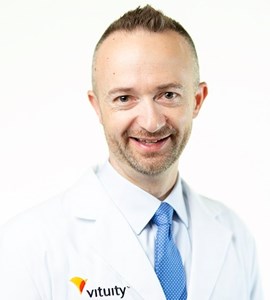In the past several years, many hospital emergency departments (EDs) have focused on improving throughput — often with positive results. But one group of vulnerable patients is still waiting for change. And waiting.
Due to funding cuts and the closure of inpatient psychiatric facilities, patients experiencing a mental health crisis often end up boarded in EDs for days. In some underserved areas, stays of over a week aren't unusual.
This is unfortunate, because the ED is far from an ideal environment for mental health patients. It's chaotic. It's noisy. And unless the team is lucky enough to have access to an on-call psychiatrist, treatment is often limited to crisis management (e.g., medications to control an outburst).
The boarding of mental health patients impacts all patients. Boarding limits beds and resources available for people experiencing heart attack, stroke and trauma, resulting in longer waits, care delays and ambulance diversions.
The time has come for change. We are part of a group of emergency physicians who decided to make a difference in the way these patients are treated. By working closely with our hospitals and county government, we are bringing about systematic change that allows emergency physicians to more actively manage psychiatric patients' care from arrival to disposition. Our goal: to end long waits in the ED for mental health patients and to expedite both their treatment and transfer to the appropriate care environment.
Roots of the Problem
In 2009,
Sacramento County lost about half of its inpatient psychiatric beds to budget cuts. Also on the chopping block was a crisis stabilization unit where patients could be observed prior to inpatient hospitalization. As a result, the county's EDs became de facto mental health triage centers and holding areas, while wait times for inpatient psychiatric beds skyrocketed.
As ED physicians, we were shocked by the long waits our psychiatric patients now endured. We found it inhumane to leave them in the hallways for a week at a time, neither receiving necessary and appropriate treatment nor talking to anybody.
The problem was compounded by the county's application of state laws. California's Lanterman-Petris-Short (LPS) Act, also known as Section 5150, allows certain personnel, including police officers and mental health workers, to place 72-hour holds on dangerous or gravely disabled patients. Such a hold must be in place before a patient is transferred to a psychiatric hospital for assessment and care. In addition, Sacramento County interpreted the 5150 law to mean that a patient on a hold couldn’t be legally discharged from the ED.
Physicians in many California counties regularly write and release holds for psychiatric patients. However, in Sacramento County we were obligated to wait for a mobile crisis team to arrive and handle LPS matters. During the day, they were usually pretty quick, but at night, they could take up to eight hours to show up. What's more, the crisis team required patients to meet strict and arbitrary criteria before they'd even respond. (For example, the patient had to be “medically cleared” and have a low blood alcohol level under 0.12, regardless of clinical sobriety.)
This lack of control by emergency physicians created all sorts of strange scenarios. A police officer might place a hold on an intoxicated patient who required no more than sobering and follow-up. Yet due to the bureaucracy involved, the patient would be stuck in the ED for a day or more waiting for the hold to be lifted.
On the opposite end of the spectrum, we saw patients who were clearly going to require inpatient psychiatric hospitalization. But instead of placing an immediate hold, we had to jump through whatever hoops were necessary to medically clear the patient,
then call the crisis team and wait — extending by several hours what was already a long process.
Needless to say, these long waits were very tough on the patients and didn't promote positive outcomes. They were also costly. On top of direct and opportunity costs, hospitals were obliged to hire "sitters" to supervise the patients on holds for hours, days or weeks. Clearly, something needed to change.
Working Together Toward Solutions
The Emergency Care Committee of the Sierra Sacramento Medical Society (composed of all ED medical directors in the county) was first to respond to the growing crisis in mental health care. In 2011, they invited the CEOs of all the county's psychiatric facilities to the table. The ED medical directors called for uniform printed medical clearance criteria, access to the physician on duty if a patient’s acceptance to a mental health facility was denied and for greater collaboration in expediting and improving the quality of care for this patient population.
The cause gained further momentum in 2013, when Vituity began staffing all of the Dignity Health hospital EDs. Our medical directors were keen to boost operational performance and began compiling throughput data from across facilities. Together, we identified psychiatric patients as an area of great concern — and also of great opportunity for change. By reducing boarding of these patients, we estimated we could save the health system $16 million a year.
To begin the process, the medical society invited Tom Sugarman, MD, to speak. Dr. Sugarman, a Vituity Partner and past-president of California ACEP, had participated in numerous advocacy efforts on behalf of psychiatric patients, including California ACEP's successful lobbying efforts for clearer, more patient-friendly laws, which were enacted in 2007.
Based on advice from Sugarman — and from colleagues across the Partnership — Vituity physicians, under the leadership of Seth Thomas, MD, and Kendrick Johnson, MD, presented the Dignity Health administration with a package of solutions that we are now putting into place:
- LPS Certification. Emergency physicians from the medical society and Dignity Health met with the county mental health director and proposed a pathway for emergency physicians to become LPS-certified. This led to the training and certification of a core group of eight ED physicians, who are now designated by the county to write and release holds, with a goal to certify all Sacramento Dignity Health ED physicians within a year.
- Telepsychiatry. Dignity Health's EDs had successfully utilized teleneurology within its stroke program for several years. Using the same equipment and process for psychiatric patients gives the ED team 24-7 access to expert consultation that can be used to prescribe and adjust therapeutic medications. Psychiatrists are also able to endorse the writing and lifting of LPS holds. One advantage of using telepsychiatry is that the consult can begin immediately, even before the patient is formally "medically cleared."
- Daily rounding. Dignity Health ED physicians and nurses have begun rounding together to review the plan of care for each psychiatric patient. This allows them to assess how the patient is responding to treatment and whether they might be safely discharged.
- Policy development. Dignity Health is working with Vituity to create new protocols that will allow disposition planning to begin immediately for both low-risk psychiatric patients (who will likely be discharged) and high-risk patients (who will likely require transfer to a psychiatric facility).
A Work in Progress
While we're still in the process of implementing and testing these solutions at Dignity Health, we've already noticed some positive changes. In particular, length of stay is decreasing for the low- to moderate-risk patients, who no longer wait days for the wheels of bureaucracy to turn.
Long waits continue for high-risk patients who truly need hospitalization. Even when holds are placed quickly, it can still take days for an inpatient bed to open. To tackle the problem, we hope to refine our telepsychiatry protocols to treat some of the sicker patients during the waiting period. If we can determine very quickly that the patient is a good candidate for rapid treatment, we believe we can get this treatment started and see them leave in a day or two rather than waiting up to a week for an inpatient bed.
While work remains to be done, we are very excited to see advocacy efforts work synergistically with operational improvements to effect positive change for our patients. We have successfully improved the care we deliver while decreasing the cost of that care —a win for patients, our communities and our hospitals!
[Image credit:
"Melancholy 2" by
Andrew Mason licensed under
CC BY 2.5.]
























